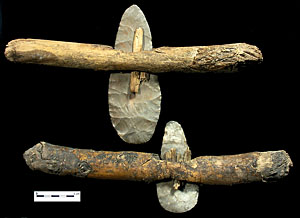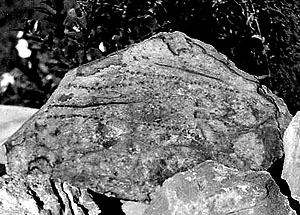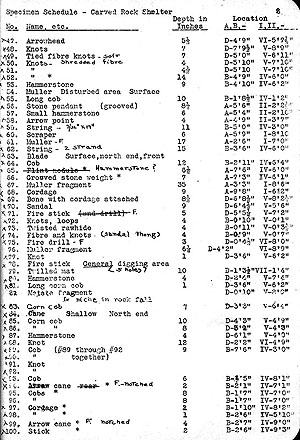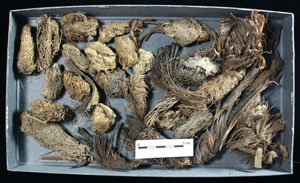Carved Rock Shelter
Carved Rock Shelter is located in the Sunny Glen Canyon, near Alpine in Brewster County. The dry rockshelter is known for its rock carvings and pictographs, but it also produced a remarkable array of perishable and nonperishable artifacts that reveal much about how its inhabitants lived.
Pioneering Big Bend archeologist Victor Smith first visited Carved Rock Shelter in 1921 and removed a fragment of basketry that he found outside of the rock shelter. He returned the following year and removed more surface artifacts, but did not carry out substantive work at the site until 1932 when the West Texas Historical and Scientific Society conducted a regional survey of the Big Bend area. After a test pit produced promising results, Smith excavated Carved Rock Shelter in September of that year in a joint project between the society and the Gila Pueblo research center in Arizona. Carved Rock Shelter is one of more than 800 sites that were surveyed that year by the Gila Pueblo team under the direction of E. B. Sayles.
Smith excavated Carved Rock Shelter with a small party of volunteers and students, including a young J. Charles Kelley. Kelley first became interested in archaeology while attending Sul Ross State Teacher’s College in Alpine, where he took classes from Smith. Smith encouraged his interest and asked him to volunteer in the Carved Rock Shelter excavation. After the excavation, Kelley went on to earn his B.A. and Ph.D. in archeology and work at dozens of sites in the Southwest and northern Mexico in a career that spanned more than 50 years. He is best known for his pioneering work at La Junta de los Rios.
Carved Rock Shelter takes its name from the varied and extensive patterns carved into its rock. It contains 33 distinct rock carvings in three different styles. The older style consists of small drilled holes accompanied by lines or grooves. In addition to these wall carvings, six individual stones were recovered from the site that are carved in a similar style, with grooves or drilling on both sides. The two more recent styles of rock carving consist of “V” shaped grooves of various sizes and orientations, and radial lines carved around storage pits that are dug into the rock. The site also contains three small pictographs. One is orange and depicts a circle with two parallel diagonal lines. The other two are red and depict a wishbone shaped object and a small circle within a rectangle.
Carved Rock Shelter experienced a large rock fall in 1914 and several smaller rock falls during the earthquake of 1931 that blocked its entrance, affording it protection from looters until it was excavated by Smith. As a result, an impressive array of both perishable and nonperishable artifacts were preserved in place in the shelter. Unfortunately, Smith recorded these artifacts simply by measuring their depths from the surface, meaning that little is known about their horizontal provenience or depositional context.
Carved Rock Shelter's wooden artifacts were made out of the flower stalks of locally available desert plants, such as sotol, yucca, and lechuguilla. They include arrow shafts, arrow foreshafts, firehearths, and firedrills. Its plant fiber artifacts were made primarily out of the leaves of various species of agave and yucca. They include cordage, knots, fragments of basketry and matting, a bowstring, and sandals of the fishtail, roundtoe, plaited, and diagonally woven styles. Rawhide and skin that had been punched for sewing was also recovered from the shelter. One of the site's unusual perishable artifacts is a polished bone attached to a piece of cordage—this tool may have been used to weave mats.
Perhaps the most remarkable artifacts from Carved Rock Shelter are two hafted bifaces that have been called "agave knives." In a 1981 interview conducted by Curtis Tunnell, Kelley recalled:
It was my first excavation project. One lunch period when we stopped digging, young and inquisitive, I was fooling around and I reached into a crevice between two of these great fallen bloulders and pulled out a length of solotl stock with a flint blade inset into the middle of it. Victor asked, "Where did you find that?" And I said "Right in here," and reached in and pulled out the second one. (Tunnell 1992:34)
A total of 183 stone artifacts were recovered from Carved Rock Shelter including the two hafted bifaces and a third biface that Smith believes was also hafted at one point in time. Other lithic artifacts include flakes, end scrapers, scraper planes, cores, bifaces, bifacial knives, drills, projectile points, manos, metates, hammerstones, abrading stones, and ornaments. Use wear analysis of the site’s scraper planes conducted at the Texas Archeological Research Laboratory at the University of Texas at Austin during the early 1990s, suggests that they were used to press the pulp out of lechuguilla leaves.
The only projectile point from the site that has been definitely typed is a Livermore arrow point, but there are also arrow points resembling the Figueroa and Perdiz types, as well as possible Shumla and Nolan dart points. Based on the typology of these projectile points, the rockshelter was utilized from the Late Archaic through the Late Prehistoric period.
One mortar hole and five storage pits were found dug into the soft rock of the floor of Carved Rock Shelter. The mortar hole was likely used for pulverizing hard seeds and seed pods, such as mesquite beans. The storage pits were lined with prickly pear pads, grasses, sticks, branches, and even old mats and sandals. They were probably used to store plant food that could be processed and eaten in the winter.
Because recovering organic remains was not standard procedure for archeologists in the 1930s and methods of recovery were not very sophisticated, few floral and faunal remains have been recovered from Carved Rock Shelter. The only floral remains from the site that were given much attention by its excavators are 20 corn cobs and cob fragments. There is no evidence to determine whether the people who camped at the site grew this corn in the vicinity, grew it elsewhere and brought it to the site, or obtained it from other groups who practiced agriculture. A large quantity of quids (chewed masses of lechuguilla fiber) was also recovered from the site. Carved Rock Shelter's only identifiable faunal remains are those of deer and antelope.
Though Carved Rock Shelter was not excavated with a high degree of sophistication or precision, its artifacts can still reveal information about how its inhabitants lived. The typology of the site’s artifacts indicates that it was occupied from the Late Archaic period through the Formative period. Evidence of hunting comes from the presence of projectile points, a bow string, and deer and antelope remains, but the site’s lithic assemblage is geared more toward the processing of plants. Grinding tools and storage pits suggest that plant foods could have been brought to the site to be stored throughout the year, then processed during the winter. Evidence for the exploitation of desert succulents is also suggestive of a winter occupation, because these plants become most plentiful during the cooler months.
Contributed by Carly Whelan.
Sources
Bither, Jennifer A.
1992 A Description of the Artifacts from Carved Rock Shelter, Brewster County, Texas. Manuscript on file, Texas Archeological Research Laboratory, University of Texas, Austin.
Smith, Victor J.
1933 (entry in:) Archaeological Field Work in North America during 1932. American Anthropologist 35(3):483-511.
1934 Carved Rock Shelter: A Report on Dry Rock Shelter Excavation in the Big Bend of Texas. Circular 2, West Texas Historical and Scientific Society, Manuscript on file, Alpine 210, Sayles Collection Files, Texas Archeological Research Laboratory, University of Texas, Austin.
1938 Carved Rock Shelter: A Report on Dry Rock Shelter Excavation in the Big Bend of Texas. Texas Archeological and Paleontological Society Bulletin 10:222-233.
Tunnell, Curtis
1992 Victor J. Smith: Pioneer Archeologist. Journal of Big Bend Studies 4:33-42..
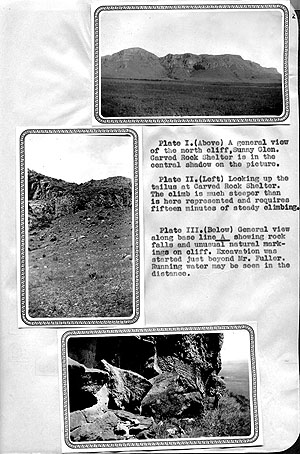
|
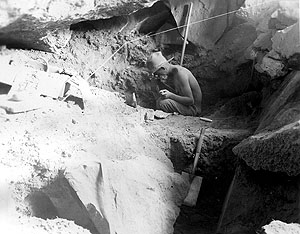
|
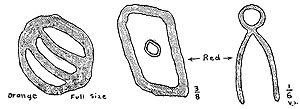
|
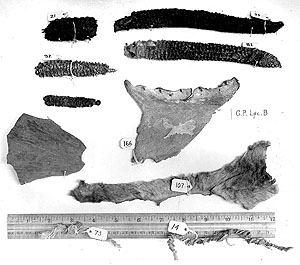
|
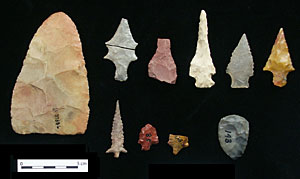
|
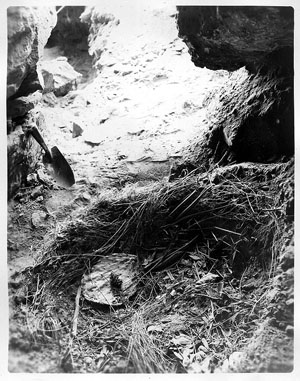
|
